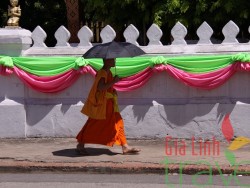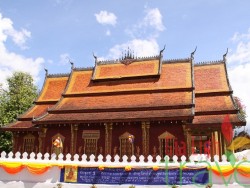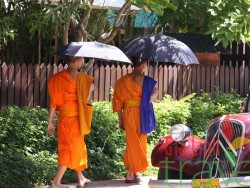Lao Religon
Laos Religion
Lao Religon Lao Religon “Sixty percent of Lao people are practicing Buddhists, and that fact colors every facet of life. Temples and stupas dominate the architecture of even the smallest village, and you’re sure to spot groups of monks in colorful robes — best on their early morning pintabat, or alms rounds, especially in Luang Prabang. Buddhist acceptance and compassion play an important part in Lao culture; arguments are the exception and the sangha, or monastic community, fosters a strict moral code. Even the shortest visit to Laos offers unique insight into Buddhist culture.” Predating Buddhism, the worship of animist spirits (phi) in Laos represents some of the region’s most ancient religious practice. Animist shrines may be found in many parts the country. The origins of Luang Prabang (Muang Sua) are deeply bound up with the legend of Khun Borom’s loyal servants Phou Nheu and Nha Nheu, who to this day are revered as the settlement’s devata luang or guardian deities at a shrine in the grounds of Wat Aham. Similarly, many residents of Vientiane still venerate the lak muang or district pillar at Wat Simuang, which is believed to contain the guardian spirit of the city. Animism continues to permeate many aspects of Lao Buddhist ritual, and even the traditional Lao baci ceremony, commonly held to bestow good luck by the tyeing of white strings around the wrist when people receive promotion, move house, start a new job, marry or have a new baby, is derived from the worship of guardian spirits known as khuan. Buddhism was introduced into the region as early as the first millennium CE, but was not widely practised amongst the Tai principalities until the late 13th or early 14th centuries. Fa Ngum (1353-1371), founder of Lane Xang, established Buddhism as the state religion, but it is clear that the worship of animist spirits continued to predominate for centuries after this, prompting the devout Buddhist King Photisarath in 1527 to promulgate an edict banning the worship of spirits and construct Luang Prabang’s Wat Aham and Vientiane’s Wat Simuang on the sites of the afore-mentioned animist shrines. After moving the capital to Vientiane, Phothisarath’s son King Sai Setthathirat I (1550-1571) made strenuous efforts to make Vientiane a regional Buddhist centre. However, Buddhism only gained a firm foothold in Lao society during the 17th century, when it began to be taught in schools. Today some 60 per cent of the Lao population (predominantly lowland Lao and some other Tai-speaking groups) follow Theravada (Hinayana or ‘small vehicle’) Buddhism, which was based on the earliest teachings of the Buddha and was preserved in Sri Lanka after Mahayana Buddhism branched off in the second century CE; Theravada Buddhism is also the dominant school in Thailand, Cambodia and Myanmar. Buddhism is an inherent feature of daily life in Laos and an important influence on Lao society and culture. Almost every Lao Buddhist male becomes a monk for a short period of time, usually before marrying, and many young boys spend long periods as novices in temples, earning their families ‘merit’. Most Lao Buddhists try to gain ‘merit’ for a better next life by giving donations to their local wat and through regular worship. The Lao Buddhist sangha (monks and novices, the clergy) has been organised into the Lao Buddhist Fellowship Organisation, a mass organisation established in 1976 with the aim of managing, developing and educating its members and ensuring that they observe the laws of the country. Most of the ethnic minority communities practise a combination of animism and ancestor worship, but some Mon-Khmer, Hmong and Yao communities hold Christian beliefs. Vientiane’s tiny Islamic Cham community worships at the Alaishad Mosque in Ban Pounsawat Tai (known locally as Wat Khmer). The Vientiane Jamia Masjid near Nam Phu Square in the centre of the city is used primarily by Islamic settlers from India, Pakistan and Bangladesh.


